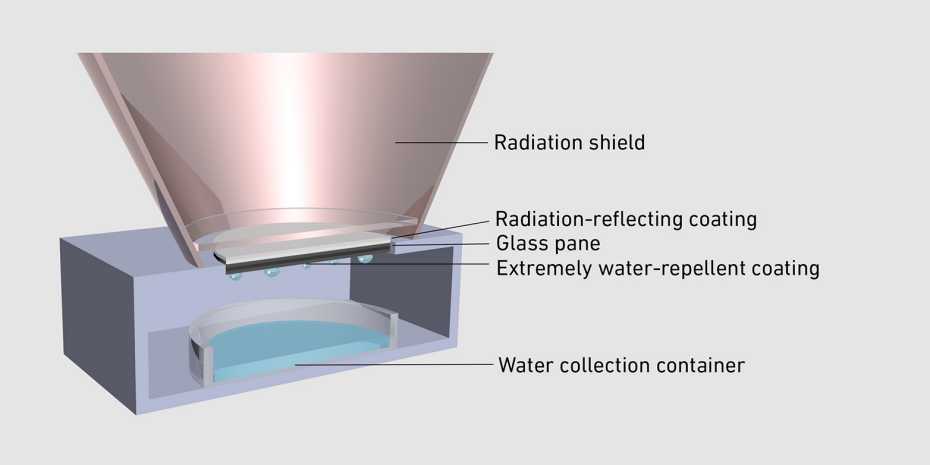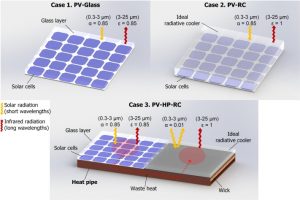via PV Magazin | Thermal management of solar cells is of vital importance to maintain adequate electrical efficiency. Lately, radiative cooling (RC) of solar cells has been researched extensively because of its passive nature and structural simplicity. However, commercial solar cells are usually encapsulated with highly emissive glass covers, and therefore the additional potential to reduce the cell temperature through RC is not significant. This study proposes a new system configuration to maximize the RC potential. It consists of a photovoltaic module for electricity generation, an RC module for heat removal to the sky, and a heat pipe for quick and efficient heat transfer between the two modules. A comparative analysis of temperature reduction and efficiency improvement between the proposed and previously studied systems is performed. The influence of input parameters (i.e., solar radiation, ambient temperature, wind speed, atmospheric emissivity, radiator length, and heat pipe resistance) on the system performance is also studied using COMSOL. Results show that in contrast to the conventional glass-coated module, the proposed system gives a maximum cell temperature reduction of 12.86 °C, which corresponds to a 7.25% relative rise in electrical efficiency. The new configuration’s enhanced thermal performance supports it as an alternative to the glass-coated or ideally emissive photovoltaic modules. By addressing the challenge of limited radiative sky cooling, researchers can eventually move a step ahead and use this study for the thermal management of other devices and not just solar photovoltaics. Enhancedradiativecoolingofsolarcellsbyintegrationwithheatpipe
-
Lightweight, Passive Radiative Cooling to Enhance Concentrating Photovoltaics
Radiative cooling can reject significantly more waste heat than convection and conduction at high temperatures by sending it directly into space. As a passive and compact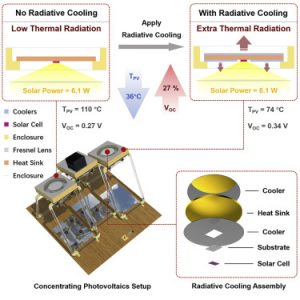 cooling mechanism, radiative cooling is lightweight and does not consume energy. These qualities are promising for thermal management in outdoor systems generating low grade heat, such as concentrating photovoltaics (CPV) and thermophotovoltaics (TPV). In this work, we first simulate radiative cooling for a wide range of working conditions, including heat loads from 6 to 100 W with different CPV cooling designs. We then demonstrate a CPV system integrated with radiative coolers, achieving a 5°C to 36°C temperature drop and an 8% to 27% relative increase of open-circuit voltage for a GaSb solar cell, under a heat load of above 6 W with different cooling designs. We show that the temperature drops from radiative cooling may significantly improve CPV system lifetimes. RadiativeCPV
cooling mechanism, radiative cooling is lightweight and does not consume energy. These qualities are promising for thermal management in outdoor systems generating low grade heat, such as concentrating photovoltaics (CPV) and thermophotovoltaics (TPV). In this work, we first simulate radiative cooling for a wide range of working conditions, including heat loads from 6 to 100 W with different CPV cooling designs. We then demonstrate a CPV system integrated with radiative coolers, achieving a 5°C to 36°C temperature drop and an 8% to 27% relative increase of open-circuit voltage for a GaSb solar cell, under a heat load of above 6 W with different cooling designs. We show that the temperature drops from radiative cooling may significantly improve CPV system lifetimes. RadiativeCPV
-
A Self-Assembled 2D Thermofunctional Material for Radiative Cooling
The regulation of temperature is a major energy-consuming process of humankind. Today, around 15% of the global-energy consumption is dedicated to refrigeration and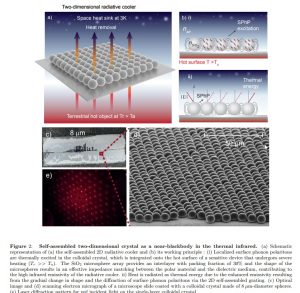 this figure is predicted to triple by 2050, thus linking global warming and cooling needs in a worrying negative feedback-loop. Here, an inexpensive solution is proposed to this challenge based on a single layer of silica microspheres self-assembled on a soda-lime glass. This 2D crystal acts as a visibly translucent thermal-blackbody for above-ambient radiative cooling and can be used to improve the thermal performance of devices that undergo critical heating during operation. The temperature of a silicon wafer is found to be 14 K lower during daytime when covered with the thermal emitter, reaching an average temperature difference of 19 K when the structure is backed with a silver layer. In comparison, the soda-lime glass reference used in the measurements lowers the temperature of the silicon by just 5 K. The cooling power of this simple radiative cooler under direct sunlight is found to be 350 W m−2 when applied to hot surfaces with relative temperatures of 50 K above the ambient. This is crucial to radiatively cool down devices, i.e., solar cells, where an increase in temperature has drastic effects on performance. Aself-assembledtwo-dimensionalthermo-functionalmaterialforradiativecooling.
this figure is predicted to triple by 2050, thus linking global warming and cooling needs in a worrying negative feedback-loop. Here, an inexpensive solution is proposed to this challenge based on a single layer of silica microspheres self-assembled on a soda-lime glass. This 2D crystal acts as a visibly translucent thermal-blackbody for above-ambient radiative cooling and can be used to improve the thermal performance of devices that undergo critical heating during operation. The temperature of a silicon wafer is found to be 14 K lower during daytime when covered with the thermal emitter, reaching an average temperature difference of 19 K when the structure is backed with a silver layer. In comparison, the soda-lime glass reference used in the measurements lowers the temperature of the silicon by just 5 K. The cooling power of this simple radiative cooler under direct sunlight is found to be 350 W m−2 when applied to hot surfaces with relative temperatures of 50 K above the ambient. This is crucial to radiatively cool down devices, i.e., solar cells, where an increase in temperature has drastic effects on performance. Aself-assembledtwo-dimensionalthermo-functionalmaterialforradiativecooling.
-
Thermal model of a photovoltaic module with heat-protective film
Research on reducing the working temperature of PV modules is gaining attention to improve their electrical performance, efficiency, and life especially in warm climatic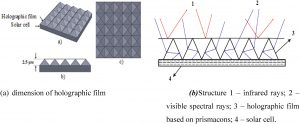 conditions. This study describes the use of novel heat-protective film based on holographic coating with a total internal reflection prism layer applied to maintain the operating temperature of the photovoltaic module. A mathematical model of thermal protection based on the holographic film is described. MATLAB/Simulink simulation was used to estimate the current-voltage and output power–solar irradiance characteristics of a photovoltaic module with and without holographic film. Regression models were developed based on field testing to determine a relationship between the temperature of heat-protected/unprotected PV panels and ambient temperature. The results showed that a temperature reduction of 3.54 °C is obtained for solar modules with thermal protection film compared to the one without holographic film. The modeling and field performance results confirm the effectiveness of the thermal protective film in reducing the temperature and improving the photovoltaic panel performance in hot climates
conditions. This study describes the use of novel heat-protective film based on holographic coating with a total internal reflection prism layer applied to maintain the operating temperature of the photovoltaic module. A mathematical model of thermal protection based on the holographic film is described. MATLAB/Simulink simulation was used to estimate the current-voltage and output power–solar irradiance characteristics of a photovoltaic module with and without holographic film. Regression models were developed based on field testing to determine a relationship between the temperature of heat-protected/unprotected PV panels and ambient temperature. The results showed that a temperature reduction of 3.54 °C is obtained for solar modules with thermal protection film compared to the one without holographic film. The modeling and field performance results confirm the effectiveness of the thermal protective film in reducing the temperature and improving the photovoltaic panel performance in hot climates
1-s2.0-S2214157X21009072-main. 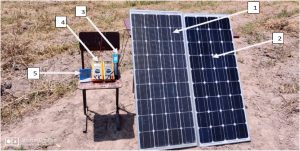
Temperature Coefficient Calculator
Power in Watts (W) and Temperatur (C°) Calculation:
See also - contact me
- Energy conversion
- Amortisation LCOE
- Power conversion
- Off-Grid Configurator
- kWh to watts calculator
- Watts to kWH calculator
- kW to Ah to kg Calculation
